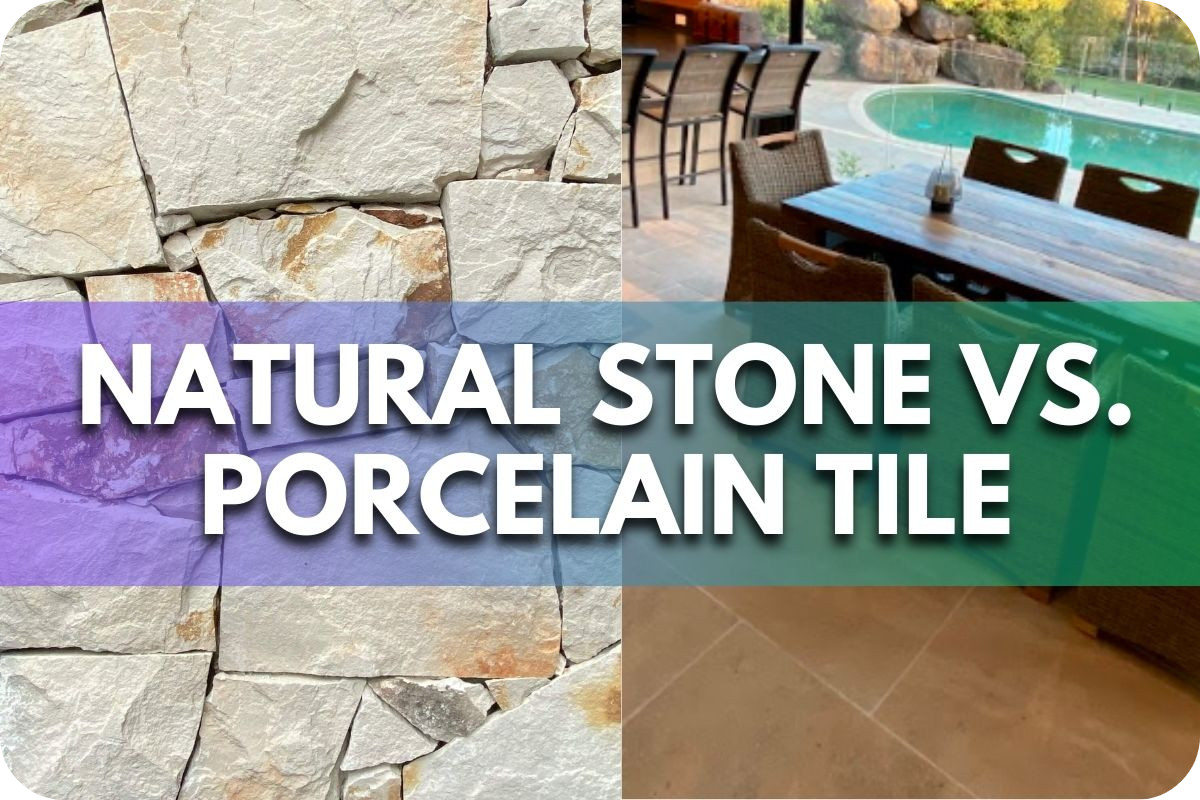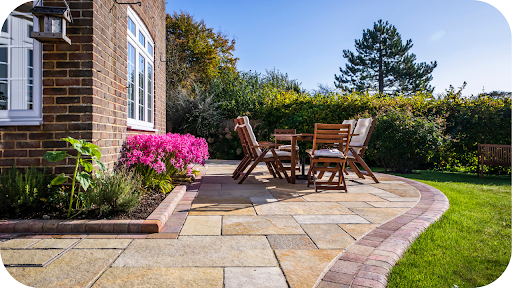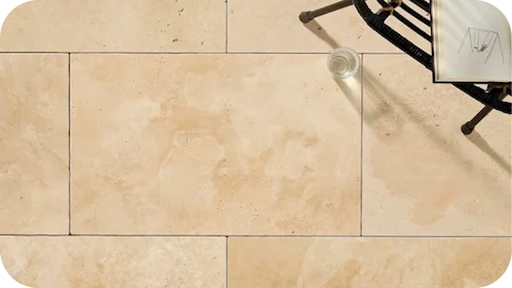
Choosing between natural stone and porcelain tile for your flooring can be challenging.
With so many factors to consider, such as durability, maintenance, and aesthetics, it’s easy to feel overwhelmed.
In this comprehensive comparison, we’ll break down the key differences between natural stone and porcelain tile to help you make an informed decision for your next home improvement project.
Composition and Production Process
1. Natural Stone
Natural stone, formed over thousands of years under immense pressure, is quarried directly from the earth’s crust.
Once extracted, it’s cut into manageable blocks using wire saws or explosives. These blocks undergo further processing, including cutting, grinding, and polishing, to create slabs or tiles of various sizes and thicknesses.
The final product retains the unique characteristics of the original stone, such as veining and colour variations, adding natural beauty to any space.
Natural stone’s production process preserves its authenticity and individuality, making each piece distinct and enhancing the aesthetic appeal of interior and exterior surfaces.
2. Porcelain Tile
Porcelain tile is an engineered product crafted from clay, minerals, and various additives.
These components are pressed into shape during manufacturing and fired at high temperatures to create a dense, durable material.
Glazing, an optional step, adds colour and design versatility. This process results in a uniform, non-porous surface suitable for various applications, from floors and walls to outdoor spaces.
Porcelain tiles often mimic the appearance of natural stone or other materials.
Durability and Strength
1. Natural Stone
The natural stone exhibits remarkable durability and strength, with variations based on the type of stone.
Factors like hardness, density, and porosity influence its resilience. Granite, for instance, is renowned for its exceptional durability and resistance to scratching and heat, making it suitable for high-traffic areas like bathroom surfaces.
Conversely, softer stones like marble may require more maintenance to prevent scratching and etching.
Understanding these distinctions helps in selecting the most suitable stone for specific applications.
2. Porcelain Tile
Porcelain tile boasts impressive durability and strength, rivalling that of natural stone.
Its uniform composition, created through pressing and firing clay and minerals, enhances its resilience against scratches, stains, and fading.
Porcelain’s inherent toughness makes it suitable for high-traffic areas like kitchen floors and bathroom walls, where it can withstand daily wear and tear.
Its resistance to moisture absorption also makes it an ideal choice for outdoor installations and wet environments like showers and pools.
Aesthetic Appeal and Variation
1. Natural Stone
Natural stone captivates with its unparalleled aesthetic appeal and inherent variation.
Each slab or tile showcases a distinct blend of colours, patterns, and textures, making every installation a masterpiece.
From marble’s rich veining to travertine’s earthy warmth, natural stone infuses spaces with timeless elegance and organic charm.
Its natural imperfections and irregularities add character and depth, creating visually captivating surfaces that stand out in any interior or exterior design scheme.
2. Porcelain Tile
Thanks to advanced printing and glazing technologies, porcelain tile excels at replicating the appearance of natural materials like stone and wood.
These processes allow for intricate designs and textures closely resembling the real thing.
Unlike natural stone, porcelain tile offers consistency and uniformity in appearance, making it an attractive option for achieving a cohesive look across installations.
While lacking the organic variation of natural stone, porcelain tile’s controlled aesthetics appeal to those seeking a polished and uniform finish in their spaces.
Maintenance and Care
1. Natural Stone
Natural stone requires regular maintenance to keep its beauty intact.
This includes routine cleaning with pH-neutral cleaners and periodic sealing to protect against stains and damage.
Resealing may be necessary over time, depending on the stone type and usage.
Proper maintenance enhances the appearance of natural stone and prolongs its lifespan, ensuring that it remains a stunning feature in your space for years to come.
2. Porcelain Tile
Porcelain tile offers remarkable durability and low maintenance compared to natural stone.
Its non-porous surface makes it resistant to stains, scratches, and moisture, requiring only regular cleaning with water and mild detergent.
This simplicity in maintenance makes porcelain tile an excellent choice for high-traffic areas and wet environments. It provides long-lasting beauty with minimal effort.
With advanced printing and glazing technologies, porcelain tile can achieve a consistent appearance. It offers homeowners the aesthetic appeal of natural materials with the added benefits of durability and easy maintenance.
Cost Considerations
1. Natural Stone
Natural stone’s cost factors are influenced by several variables, including the specific type of stone chosen (such as marble, granite, or travertine), its rarity or availability, and the distance it needs to travel from the quarry to its final destination.
Despite potentially higher upfront costs, natural stone is often considered a long-term investment due to its enduring beauty and ability to increase the value of a property over time.
Additionally, factors like installation complexity and maintenance requirements can impact the overall cost of natural stone projects, making it essential for homeowners to carefully consider both short-term expenses and long-term benefits when evaluating their options.
2. Porcelain Tile
Porcelain tile often presents a more budget-friendly alternative to natural stone, catering to diverse price points without compromising aesthetics.
Its lower upfront cost can appeal to homeowners seeking high-quality materials within a tighter budget.
While natural stone may require a higher initial investment, its enduring beauty and long-term value can justify the expense for those who prioritise timeless elegance.
Ultimately, weighing the upfront cost against the overall value and durability is crucial when deciding between these two materials for a project.
Conclusion
Understanding the disparities in composition, durability, aesthetics, maintenance, and cost is crucial when weighing the options between natural stone and porcelain tile.
Tailoring your choice to your unique requirements and budget ensures satisfaction.
Contact Splendour In Stone Melbourne for expert advice and seamless installation, making your design aspirations a reality.
More To Explore

Natural Stone Pavers Melbourne: Stylish Outdoor Solutions
Natural stone pavers remain a stylish choice for outdoor spaces in Melbourne. Their timeless appeal, unique textures, and natural strength suit gardens, patios, courtyards, alfresco

Travertine Supplier Melbourne: Choosing Quality Stone for Lasting Designs
Travertine has long been admired for its timeless beauty and natural charm, making it a favourite in Melbourne homes and commercial spaces. Its unique textures


